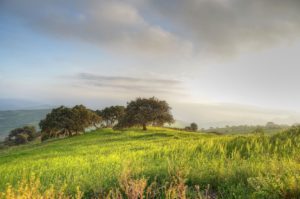Choosing Plants for a Sustainable Garden Design
 With the aim of making a positive impact on the environment, sustainable gardening involves working with nature not against it. Organic gardening practices including the elimination of harmful artificial additives and the conservation of natural resources are important in creating an eco-friendly backyard. Gardening in harmony with nature like this is made much easier when you include native shrubs, pollinator-friendly flowering plants and resilient trees in your garden design. As well as requiring less maintenance, these plants will help to provide essential food and habitats for wildlife. While the preservation of ecosystems shouldn’t be neglected in favor of aesthetics, with a love and respect for nature there is no need to compromise on attractive and vibrant landscape design in order to create a more sustainable garden.
With the aim of making a positive impact on the environment, sustainable gardening involves working with nature not against it. Organic gardening practices including the elimination of harmful artificial additives and the conservation of natural resources are important in creating an eco-friendly backyard. Gardening in harmony with nature like this is made much easier when you include native shrubs, pollinator-friendly flowering plants and resilient trees in your garden design. As well as requiring less maintenance, these plants will help to provide essential food and habitats for wildlife. While the preservation of ecosystems shouldn’t be neglected in favor of aesthetics, with a love and respect for nature there is no need to compromise on attractive and vibrant landscape design in order to create a more sustainable garden.
Introduce Hardy Native Plants
As well as providing color and interest to your backyard, native plants enrich the environment and will greatly improve the sustainability of any garden design. This is because they are already well adapted to the local growing conditions so they require less maintenance in the form of watering or the use of damaging pesticides and fertilizers. Strong root systems hold more water, stabilize the soil around them and absorb runoff, while perennial flowers attract wildlife and help to preserve biodiversity. Hardy, native plants are more likely to thrive in your garden as they have evolved to cope with the very specific local climate, soil and levels of rainfall, and so they are therefore generally self-sustaining. As they are more robust, native flowering plants, shrubs and trees will also add color and interest to your garden for longer.
Choose Plants for Pollinators
Native plants are also a great way to attract pollinators to your garden. According to the US Department of Agriculture, over 75% of flowering plants in the world need pollinators so that they can reproduce, and birds, bees and other insects help to sustain ecosystems and produce natural resources. By planting a wide range of plants that produce flowers of varying colors and shapes at different times of the year, you can ensure a continuous supply of nectar to attract pollinators. In return, as well as enabling you to enjoy a diverse and vibrant garden full of life, birds and bees will ensure that your flowering plants and vegetable crops are regularly pollinated and will continue to flourish.
Combat Climate Change with Trees
Pollinators and other wildlife will also be drawn to a garden containing larger shrubs and trees as they provide food and shelter for insects, birds and small mammals. However, trees are also a vital addition to a sustainable garden design for several other reasons. On a large scale, trees can combat climate change by storing carbon dioxide, but even just one or two trees in your backyard will help to absorb pollution and soak up excess storm runoff. While native trees have a greater chance of survival, as a design feature, any tree can be used in a practical way to define boundaries or delineate separate areas of a large garden. They can also be positioned to provide naturally cooler and shaded areas in a hot and sunny garden, and even rows of trees or large shrubs can provide an effective barrier against noise pollution.
Any green space is environmentally beneficial but a backyard filled with native plants and trees increases biodiversity and sustainability even more. As well as enhancing your garden design with brightly colored flowers and useful architectural shapes, hardy perennials and low maintenance trees can help to manage water use, attract pollinators and provide natural habitats for wildlife.


Sorry, the comment form is closed at this time.